Tag: Workouts
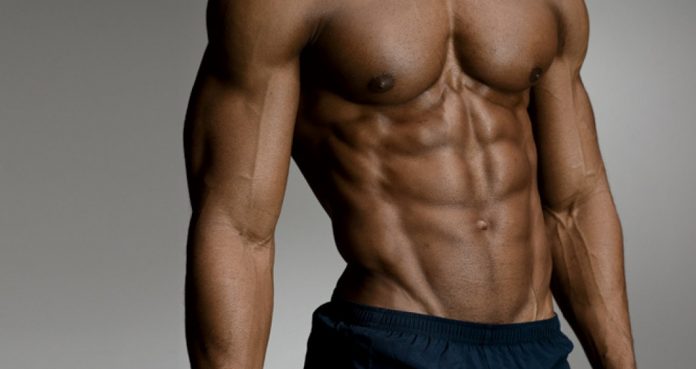
The Most Effective Ab Workout You Can Do at Home
An Ab Workout You Can Do at Your Home
A ripped midsection isn’t easy to get but can make you stand out from the crowd. The good news is, you don’t have to hit a gym in order to train your abs. You can build your abs from the comfort of your home.
Everyone has abs but they are hidden under a layer of fat. Proper diet and training can help in exposing your six-pack. A 15-20 minute ab workout is enough to carve your midriff into a masterpiece.
Lying Leg Raises – 3 Sets 20 Reps
Lying leg raises work your lower abs. Lower abs are the most stubborn fat holding section of your abdominal. If you have an access to a flat bench at your home, you can use it to increase your range of motion.
Lie with your back on the floor, your arms placed on your sides and your legs stretched out. Raise your legs so they’re perpendicular to your upper body. Slowly lower your legs so they’re 2-3 inches away from the ground. Repeat this movement for 20 reps.
Crunches – 3 Reps 30 Reps
We are taking an overall approach to training abs in this workout. Crunches work your upper and middle abs and are one of the most popular abdominal exercises. The high number of reps of this exercise will help in building definition in your midriff.
Lie on an exercise mat with your feet placed flat on the floor. Place your hands behind your head. Some people stretch out their arms and use them to generate momentum which can take off tension from the abs. Lift your upper back off the floor, breathe out and squeeze at the top of the movement. Your lower back should be touching the floor at all times.
Russian Twists – 3 Reps 15 Reps Each Side
Most people overlook training their obliques. Obliques are the fish gill-like muscles present on the sides of your abs. Russian twists are one of the most effective oblique exercises and will help you in building the V-shaped muscle in your lower abs.
Sit on an exercise mat with a slight bend in your knees and feet elevated. Hold a weight (could be a dumbbell or weight plate) in front of your chest. Rotate to your right side, breathe out and squeeze your obliques. Return to the starting position and repeat on the left side.
Reverse Crunches – 3 Sets 20 Reps
Reverse crunches are the opposite of the traditional crunches. In this exercise, you work your lower body as compared to your upper body in the traditional crunches. Reverse crunches work your lower abs.
Lie with your back on the exercise mat, arms on your sides and feet placed flat on the floor. Lift your feet off the floor and bring your knees to your chest. Hold your knees close to your chest for a second before returning to the starting position.
Planks – 3 Sets 1, 1.5, 2 Minutes Each
Planks have earned a name for themselves when it comes to core and ab training. Performing planks can strengthen your core which can help you in performing other exercises better, especially compound movements.
Place your forearms on the ground with your elbows aligned below the shoulders. Your arms should be parallel to your body at about shoulder-width distance. Perform the first set for a minute, the second set for 1.5 minutes and the last set for two minutes. Your abs will be on fire after this workout.
Which is your favorite ab exercise? Let us know in the comments below. Also, be sure to follow Generation Iron on Facebook and Twitter.
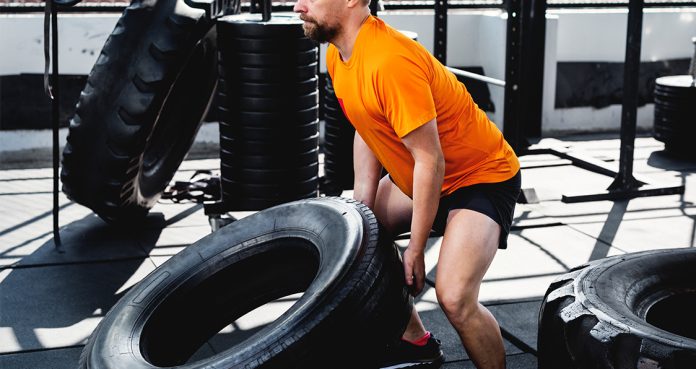
Gym Hacks and Tricks for Bigger and Stronger Muscles
Get Bigger and Stronger With These Gym Hacks
If you’re like most people, you weight train to get stronger and muscular. Sticking to the vanilla training techniques might work in the long run but why stick to the slower path when you can speed up the progress by making a few tweaks in your training?
As you incorporate the hacks in your workouts, you’ll feel an instant effect on your muscles. With the tips mentioned in the article, you can train smarter and make your workouts more effective.
Use Fat Grips
Fat grips can add to the bar width which can make it harder to hold. The difficulty in holding onto the bar recruits your forearms which can spark arm development. Although most people use the fat grip for their arm workouts, you can throw them onto the bar in almost every bar exercise like the bench press, rows, side lateral raises, etc.
A thicker bar can result in an even distribution of pressure throughout your palm which could mean lower stress on joints like the shoulders and elbows. You’ll have no choice but to acknowledge the pump using thicker grips has on your muscles.
Tweak Your Deadlifts
If you’re tall or have longer legs, deadlifting with the orthodox stance might not be the most effective technique for you. While training, you need to remember there is no “one technique fits all”. You need to experiment with the form until you find the one which works the best for you.
A tall person has to bend more as compared to a shorter guy while deadlifting. For people with longer legs, a normal deadlift might feel like what deficit deadlifts are for average height people. Performing sumo squats or using a trap bar is a better alternative for the normal deadlifts for tall people. The two variations of the deadlift are also great for people with lower back problems.
Go Beyond Failure Every Day
Most people misunderstand the concept of “overtraining” and don’t push the boundaries when it comes to training to failure. If a person is overtrained, his nervous system breakdowns, and he’ll have problems recovering from workouts or an illness.
Most people will never be able to reach the “overtrained” state even if they wanted to. While hitting failure in every workout is important, you don’t need to do so in every working set. You can train to failure in the last set of an exercise. So you’ll be hitting failure in five sets if you’re performing five different exercises in a chest workout.
Perform Pin Presses
Pin presses are one of the most effective and yet underutilized training techniques. People with shoulder rotator problem or stiff shoulder blades will have a problem in performing the compound pressing movements like bench press, military presses, etc.
Performing pin presses can reduce the tension on your joints as you can limit the range of motion to your liking. Pin presses can also help you lift heavier weights without the risk of an injury. You can also perform the pin presses on the leg exercises like barbell squats.
When in Doubt, Go Heavy
If you are a weight room regular, chances are that you regularly find yourself in a position where you don’t know how much weight to lift. In such a situation, most people make the mistake of using lighter weights in their first set.
Using weights that are too easy to lift can mean you have wasted your first set. You should always go for the challenging (read intimidating) weight. If you fail to perform the exercise with heavier weights only then you should drop down the weight. In case your first set was too easy, consider the set to be a warm-up and have a go at it again with heavier weights.
Have you ever tried pin presses in your workouts? Let us know in the comments below. Also, be sure to follow Generation Iron on Facebook and Twitter.

Does Sleep Help with Muscle Growth?
Is there any direct relation with sleep and muscle growth?
So you spend hours in the gym, pushing heavy ass weight, you eat super clean, while getting in all your protein and aminos but the gains don’t seem to be coming. Could muscle growth and sleep be related to the problem?
So what are you doing wrong?
The answer could be as simple as getting enough shut eye. As when you exercise, tiny tears develop in your muscle fibers but muscle repair only occurs when the body is resting or sleeping, and if you aren’t getting an adequate amount of sleep, your body cannot repair the muscle fibers as insufficient sleep is disruptive.
So how many hours of sleep should you get?
One Chinese study concluded that ‘there was a positive association between sleep quality and muscle strength. And men with shorter sleep duration(s), of (6 hours), had poorer muscle strength than that of men who slept for 7-8 hours’ and over’.
The study goes on to say that ‘good sleep quality is associated with greater muscle strength, while shorter sleep duration may be a risk factor for decreased muscle strength.
What actually happens while you are sleeping?
Sleep dramatically impacts your entire body, and it’s during sleep that your body recovers from exercise, repairs itself and grows new muscle tissue.
During this time your muscles also relax, and this is when your muscles are relieved of pain and tension.
When you are sleeping hormones such as testosterone, growth hormone and cortisol are produced in higher doses than throughout the rest of the day.
Testosterone
Testosterone is a hormone which determines how much muscle your body can build, and sleep is vital to this.
A 2011 study from the Journal of the American Medical Association found that ‘cutting back on sleep, may have a dramatic effect on men’s testosterone levels’.
The ‘study shows a week of sleep loss lowered testosterone levels by up to 15%’. And, that skipping sleep is the equivalent to ageing by that of 10-16 years.
And, Eve Van Caulter, director of the study, goes on to say that, ‘low testosterone levels are associated with reduced well being and vigour, which may also occur as a consequence of sleep loss’.
The study also found that 15% of the US adult working population were getting less than 5 hours of sleep a night, and for those wanting to add on quality muscle, that is nowhere near enough sleep.
Growth Hormone
Growth Hormone is also produced while we are sleeping, and this is greatly enhanced early in the night, specifically the first few hours of sleep.
And it has been concluded that ‘in adults the most reproducible pulse of growth hormone secretion occurs shortly after the onset of sleep in association with the first phase of slow- wave sleep (also referred to as SWS), and in men approximately 70% of the GH pulses during sleep coincide with SWS.’
So the first few hours of sleep are crucial as Growth Hormone is vital to the body being able to form and sustain muscle mass.
Cortisol
Cortisol is known as being the stress hormone but it plays so many other roles, and one of those is that it helps control your sleep wake cycle.
It stimulates wakefulness in the morning, which continues throughout the day, and slowly dips as the day goes on, coming to its lowest point around midnight, where melatonin and other hormones rise up in its place to bring about sleep.
Cortisol is the hormone that assists in the breaking down of muscle protein (catabolism), and in excess this catabolic hormone can decrease muscle mass and lean body mass.
What can help stop muscle breakdown?
When you are sleeping you are essentially fasting as your body is not consuming any food during that period and this is catabolic to muscle growth.
One study recommended ‘ingesting 40g of dietary protein prior to sleep to elicit a robust stimulation of muscle protein synthesis rates throughout the night’.
Another study stated that casein protein ingested ‘before sleep increased the ‘whole body protein synthesis rates and improved net protein balance’ and this is the ‘first study to show that protein ingested immediately before sleep is effectively digested and absorbed’.
So to increase the gains chug a casein shake to ensure you don’t waste away during your sleep.
So what supplements can help you sleep?
ZMA – is a supplement made from zinc, magnesium and vitamin B6. If you are zinc deficient then this supplement can boost testosterone levels, but it also helps induce sleep.
Supplements to increase anabolic potential
Glutamine- is an amino acid that prevents catabolism, promotes optimum growth hormone release and supports a strong immune system.
During sleeping periods, muscle wasting can occur due to amino acid shortage, and this can result in increased cortisol secretions and inflammation. Glutamine helps maintain a positive nitrogen balance and helps to promote repair.
BCAA’s – Branched Chain Amino Acids – have proven anabolic properties and increase testosterone and growth hormone levels.
BCAA’s can also help to blunt the rise in cortisol levels during sleep, helping to prevent catabolism and promote maximum anabolism.
So there you have it, male sure you get in a solid 8 hours and supplement accordingly to ensure all that hard work in the gym doesn’t go to waste – literally!
So until next time, keep pumping!
References
https://www.ncbi.nlm.nih.gov/pmc/articles/PMC7785053/
https://www.ncbi.nlm.nih.gov/pmc/articles/PMC5749041/
https://www.ncbi.nlm.nih.gov/pmc/articles/PMC4445839/
https://pubmed.ncbi.nlm.nih.gov/29199194/
https://www.ncbi.nlm.nih.gov/pmc/articles/PMC4755451/#:~:text=During%20NREM%20sleep%2C%20there%20is,activity%20among%20respiratory%20pump%20muscles.
https://pubmed.ncbi.nlm.nih.gov/8627466/#:~:text=Sleep%2Drelated%20secretion%20of%20GH,decrease%20wakefulness%20and%20increase%20SWS.
https://www.ncbi.nlm.nih.gov/pmc/articles/PMC1188300/
https://pubmed.ncbi.nlm.nih.gov/5675428/
https://www.ncbi.nlm.nih.gov/pmc/articles/PMC297368/
https://www.ncbi.nlm.nih.gov/pmc/articles/PMC7830980/
https://www.ncbi.nlm.nih.gov/pmc/articles/PMC4315033/
https://pubmed.ncbi.nlm.nih.gov/2307119/
https://pubmed.ncbi.nlm.nih.gov/12787547/
https://www.ncbi.nlm.nih.gov/pmc/articles/PMC5188418/#:~:text=Greater%20amino%20acid%20availability%20during,synthesis%20rates%20throughout%20the%20night.
For more news and updates, follow Generation Iron on Facebook, Twitter, and Instagram.
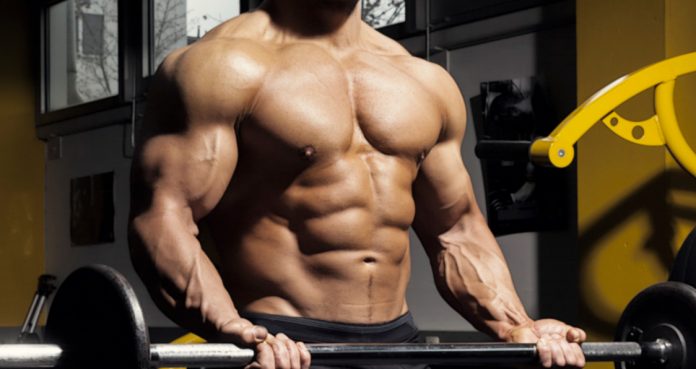
This is Why Bodybuilders Are More Jacked Than CrossFitters
Why Bodybuilders Are More Jacked Than CrossFitters
Comparing athletes from different backgrounds has become a standard, especially after the MMA athletes have started stepping into the boxing rings with their gloves on. The Connor McGregor and Floyd Mayweather fight have started a trend which is going to go on for a long time.
Bodybuilders and CrossFitters are no strangers to this comparison. Athletes from these backgrounds are compared to judge which is the better sport. Beginners make the comparison to choose between which sport they should opt for.
The Goal
While bodybuilders train to craft their physiques by building muscle mass and symmetry, CrossFitter’s workout to get fitter. The end goal of both these sports should be evident from the fact that bodybuilding shows determine the best physique on stage and the CrossFit games are meant to discover the fittest man and woman.
In a bodybuilding show, athletes are marked for the mass, symmetry, and conditioning of their muscles. In a CrossFit game, the athletes compete and have to outdo each other in the workouts.
Training
The bodybuilders train for breaking their muscle tissues and are always chasing the pump. Bodybuilders usually follow a training split and will have a set duration of rest time between working sets.
CrossFit athletes, on the other hand, follow a WOD (workout of the day) which is often a circuit which targets building strength and stamina. CrossFitters also do group workouts where a large number of people perform the same workout as a “class”.
Use of Machines
Bodybuilders use machines in their workouts to include variations and isolate their muscles. Most bodybuilding gyms are filled with numerous machines to add variety to the workouts and shock the muscles into growing.
CrossFit gyms are bare bone as compared to the bodybuilding gyms. The CrossFitters rely on functional movements in their training which usually include barbell, dumbbell, kettlebells, and pull-ups bars and don’t use a lot of machines.
Nutrition
It is no secret bodybuilders love protein. Bodybuilders follow a diet plan along with their training program. The bodybuilders also use supplements (now a billion dollar industry) to assist with their goals.
While the CrossFit athletes train to become the fittest individuals, their diet plans can be vastly different than that of the bodybuilders. The CrossFitters don’t usually use pre and post-workout supplements.
Advanced Training Techniques
The bodybuilders use advanced training techniques like drop sets, supersets, intraset stretching, BFR (blood flow restriction) training to shock their muscles and fill them up with blood and lactic acid. The bodybuilders will often train to muscle failure in their sets.
CrossFit athletes don’t train to exhaust their muscles and don’t use advanced training techniques. CrossFitters don’t usually target a specific muscle group like biceps or chest and will rather follow a full body workout.
Are you a bodybuilder or a CrossFitter? Let us know in the comments below. Also, be sure to follow Generation Iron on Facebook and Twitter.
*Header image courtesy of Envato Elements
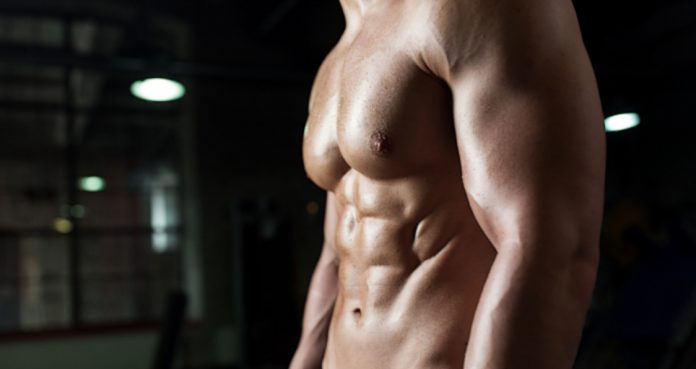
Build Six-Pack Abs at Home With This Workout
Ab Workout You Can Do at Your Home
The desire for obtaining a chiseled midriff is what gets many people to join a gym. What most people don’t realize is you don’t need to get a gym membership to build a six-pack. You can get the midsection of your dreams from the comfort of your home.
While many people train their core at home, a majority of them make the mistake of sticking to the good old crunches. You need to have a variety of exercises in your ab workouts to train your midriff from all angles.
Leg Raises – 3 Sets 15 Reps
In this workout, we won’t leave any stones unturned. We will focus on the upper and lower abs along with the obliques. If you have a hard and sturdy elevated surface at your home, perform the bench leg raises.
Otherwise, you can perform the floor leg raises. While performing the leg raises, make sure your knees are bent at a slight angle and hold the position throughout the exercise. You can also perform the hanging leg raises if you have access to a hanging bar.
Feet Elevated Crunches – 3 Sets 20 Reps
Feet elevated crunches are a variation to the normal floor crunches. In the feet elevated crunches, you can better isolate your upper abs. Lie down with your back placed on the floor and place your lower legs on an elevated surface like a bed or chair.
Your upper legs should be perpendicular to the floor and your hands placed at the sides of your head. Raise your upper body by pushing your lower back into the floor and squeeze your abs at the top of the movement as you exhale. Return to the starting position and repeat for the recommended reps.
Russian Twists – 3 Sets 15 Reps (Each Side)
A midriff can’t be deemed complete without well-carved obliques. Obliques are the fish gill-like muscles present at the sides of your abs. Most people overlook training their obliques and hence lack the definition in their mid-sections.
Sit on the floor with your knees bent so your feet are placed flat on the floor. Lean back your upper body so it forms a 60-degree angle with the floor. Extend your arms straight forward so your hands are above your knees. As you exhale, turn to your right side by twisting your torso. Return to the starting position and repeat on the left side.
Reverse Crunches – 3 Sets 20 Reps
Reverse crunches are the exact opposite of the orthodox crunches. While the crunches work the upper abs, the reverse crunches train the lower abs. Lie down with your back on the floor and place your arms at your sides.
Bend at your knees so only your heels are touching the floor. As you raise your legs, breathe in and bend your knees so that your upper legs touch your torso at the top of the movement. Return to the starting position while breathing out.
Heel Touches – 3 Sets 20 Reps Each Side
Training for toned sides can be detrimental in building a perfectly crafted midriff. The heel touches are one of the easiest exercises on this list. Lie down with your back on the floor and place your arms at your sides.
Bend at your knees so your feet are placed flat on the floor. Lift your head off the floor so that there is tension on your upper abs. Crunch at your ride side to touch your right feet. Return to the starting position and repeat on the left side.
Planks – 3 Sets 2 Minutes
Planks are an incredibly effective core strengthing exercise. Performing the planks are must for anyone who wants to train at home. A strong core not only makes your abs rock hard but also helps in performing compound movements by improving and strengthening your body stabilizers.
Get into a prone position on the floor, supporting your weight on your toes and your forearms. Bend your arms so that your elbows are directly below your shoulders and your forearms are parallel to each other. Your body should remain in a straight line throughout the exercise. Don’t let your hips sack down or form a bridge to take off the tension from your abs.
Which is your favorite exercise to perform at home? Let us know in the comments below. Also, be sure to follow Generation Iron on Facebook and Twitter.
*Header image courtesy of Envato Elements
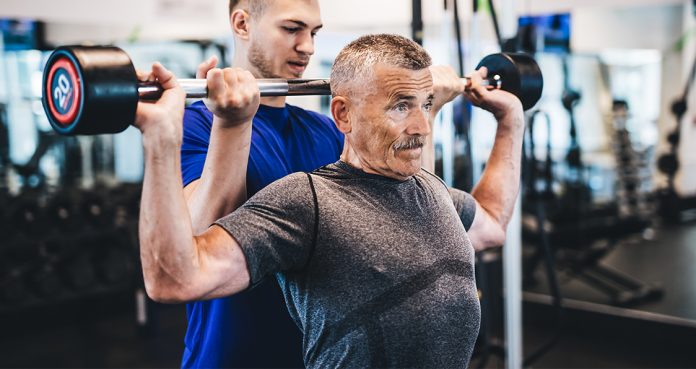
How To Approach Your Workouts After 40
How Your Training Needs To Change After You Turn 40
Your training method is going to be significantly different when you’re in your 40s as compared to your youth. Why is that, you ask? All the stair climbing, doing the monotonous chores, running after the kids takes a toll on the body and it starts to show after you’re 40.
To begin with, you want to stay away from people who generalize everyone over 40 and want them to believe that every individual is in the same condition all across the spectrum. The next time you hear someone say “age is just a number” – punch them in the face.
A Change in Priority
If you’re a muscle junkie, your best bet would be to build as much muscle as you can before you turn 40. Sarcopenia hits in when you’re around the 40-year-old mark. You will lose muscle naturally as you get older. While there are no health hazards associated with muscle loss, you can control how much muscle you lose, and when you start losing it.
With age, your workout intensity will drop and you shouldn’t be lifting heavy weights if you want to maintain your joint, muscle, and bone health. Focus on starting big and maintaining the muscle mass rather than trying to add on weight as you get older.
Basic Movement Patterns
Unlike most other sports, an individual can pursue bodybuilding for life. Bodybuilding also has the possibility of improving at ages when most athletes in other sports have called it quits. Don’t be surprised if you find a person who started bodybuilding at 15 and peaked at 40 or beyond.
Bodybuilding is a thinking person’s pursuit and everyone can work from the same basic set of principles. Some of the basic movement patterns that should become the cornerstone of your training are:
Horizontal push (pushup, bench press, fly)
Horizontal pull (row)
Vertical push (overhead press)
Vertical pull (chin-ups, pullup, lat pulldown)
Squat (squat, lunge, leg press)
Hinge (deadlift, back extension)
A Shift in Exercise Preference
While we agree compound (multi-joint) exercises like squats, lunges, deadlifts, presses, and rows are great for building strength and muscle mass, they can put you at a greater risk of an injury as you grow older.
Isolation (single-joint) exercises like curls, press downs, flies, and lateral raises are a much better option for people over 40 as they don’t consume a lot of energy, which means you can push yourself harder and recover faster.
Switch-Up the Intensity
Once you hit the 40-year mark, forget about hitting PRs on the bench press or deadlifts. Your workout program should have a higher number of reps. You’ll get better muscle growth in the 8-15 rep range, with less risk to your joints and easier recovery.
How would you know if you’re making improvements? Look for an improved form and a better mind-muscle connection. You should have shorter workouts and a better pump, or a better overall sense of well-being when you leave the gym after a workout.
Things NOT To Do
While we can go endlessly about the things you should be changing in your workouts after you turn 40, knowing about the things you shouldn’t do in the gym will set a better groundwork. These are the things you should avoid –
Exercises that put your shoulders in mechanically risky positions (dips, behind-the-neck presses, barbell upright rows)
Exercises that put your elbows under uncomfortable stress (elbow injuries always take longer to heal)
Ballistic or explosive exercises (kipping pullups, Olympic lifts)
Heavy barbell lifts (barbell squats, bench and shoulder presses, deadlifts)
How old are you? Let us know in the comments below. Also, be sure to follow Generation Iron on Facebook and Twitter.
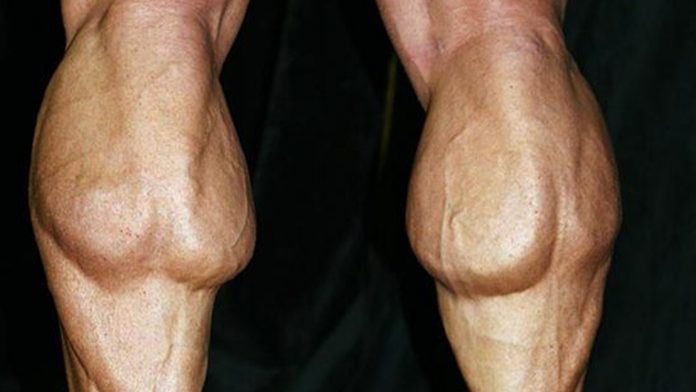
5 Reasons Why Your Calves Aren’t Growing
5 Reasons Why Your Calves Refuse to Grow
Calves can be one of the most stubborn muscle groups. Look around your gym and you’ll probably see a lot of people with skinny legs and even skinnier toothpick calves. Although calves are a small muscle group, they can be one of the hardest to develop.
Building calves can be harder for people with genetically weaker legs. If you’ve hit a plateau and your calves refuse to grow, you need to change your training program. This article will help you takes your calves game to the next level and get you ready for the summer.
1. Treating Your Calves as Accessory Muscles
Most people make the mistake of treating their calves as accessory muscles. They train their calves at the end of their workouts when there is nothing left in the tank. If you have lagging calves, you should be training them at the beginning of your workouts.
Don’t perform a single calf exercise at the end of your workouts. Do 12-15 sets on 3-4 different exercises targeting both your soleus and gastrocnemius muscles. Your calves should be flushed with lactic acid at the end of your workouts.
2. Sticking to the Same Training Routine
You have hit a plateau if your calves have stopped responding to your workouts. Shocking your muscles with new exercises or advanced training techniques like supersets, drop sets, intra-set stretching or blood flow restriction training is a great way to break the plateau.
You don’t need to be in the gym to train your calves and if you’re in the gym, you don’t need to use weights every time. Your own body weight is enough to get the ball rolling. If you don’t have access to calf training equipment at your gym, use an elevated platform to do the calf raises.
3. Not Training Your Calves From Every Angle
Your calves consist of three heads: inner, medial and outer. You need to train all the three heads to ensure an overall development. Switching your feet placement can make all the difference.
Pointing your toes inwards and the balls of your feet outwards will target the outer calves head. Pointing the toes outwards will target the inner head and keeping your feet neutral will work the medial head.
4. Doing Too Little
Calves are a small muscle group and can recover quickly from your workouts. A good rule of thumb to training your calves is to train them every day if they’re not sore. Toothpick calves won’t turn into full-grown bulls by training them once a week.
Three sets of standing calf raise at the end of your leg workouts aren’t good enough to budge the needle on your calf gains. Train your calves as you would train your biceps, and hit 12-15 sets.
5. Overloading
People will small calves usually engage in ego lifting and load the machines with more weights than they can handle. The range of motion is one of the key factors in calf development.
You should maintain a full range of motion and your toes should be pointed like a ballerina at the top of the movement. Establish a mind-muscle connection with your calves and pause and contract them with every repetition.
How often do you train your calves? Let us know in the comments below. Also, be sure to follow Generation Iron on Facebook and Twitter.

The Martyn Ford Workout For Intensity & Serious Muscle Growth
Photo via @martynfordofficial Instagram
This workout from Martyn Ford will ramp up intensity for your leg, back, and arm day routines.
Martyn Ford is a bodybuilder, online influencer, and actor with an absolutely massive physique. His approach to training is nothing short of intense and his workouts are geared to give him the best growth possible, so he can thrive both inside and out of the gym.
For those of us looking to see the best gains possible, we often search and search the Internet for workouts and exercises that we think will get us there. However, what we often fail to remember is that bodybuilders and other athletes we love post their workouts online, and as living proof of what those exercises can do for an overall physique, we shouldn’t neglect to use them as resources for our own personal gains. Plus, they can be a nice change of pace from our usual workouts as well.
As someone who take their workouts seriously, Martyn shows us just how intensity can fuel the best growth. While it can be easy to flounder through a workout, if you’re going to take the time to perform it, then really commit for those few hours.
Full Name: Martyn Ford
Weight
Height
Date Of Birth
Over 300 lbs.
6’8’’
05/26/1982
Profession
Era
Nationality
Bodybuilder, Social Media Influencer, Actor
2010
English
This workout from Martyn will show us just how a leg day, back day, and arm day workout should be done to see great intensity and an overall sense of accomplishment from a great workout. With our busy schedules, these workouts are short and sweet, but packed with intensity.
Photo via @martynfordofficial Instagram
About Martyn Ford
Martyn Ford was into sport and athletics from a young age and became captivated by cricket. While this wasn’t the most popular sport amongst his age group, some kids picked on him for his choice as opposed their usual choice of soccer. But Martyn was good and started to perform well and win competitions.
However, Martyn suffered an injury and an infection occurred as a result. He was forced to change directions when it came to cricket and took up bodybuilding instead. A great way to get some of his frustrations out, he found this to be something he wanted to continue.
From there, it was no stopping Martyn and his hard work inside the gym translated to outside of it. Not only is he someone to pay attention to for his physical attributes of lifting, but he is also an online influencer and actor, bringing his talents to other industries as well.
Photo via @martynfordofficial Instagram
Martyn Ford Training Routine
This Martyn Ford workout is something we can all learn from, given the select exercises and the intensity he brings. What you will find is a great leg day, back day, and arm day routine, perfect for seeing the best growth possible and adding to that massive physique. With the right approach to lifting, we can all see great gains like Martyn himself.
Leg Day
While Martyn’s sets and reps weren’t stated for this workout, what he does is decline in reps while he adds on more weight. However, he continues to work within a reasonable rep range so as to not do just one rep and call it a day.
Back Day
When it comes to Martyn’s back day, he makes sure to do 2-3 sets for each exercise that are strictly warm-ups. Everything must be loose and ready to go and with a priority on warming up, your body will be primed for action.
For those working sets, Martyn performs 6-7 reps all the way down to 1 rep. This fully depends on the weight you use and how comfortable you are in doing so. This workout is very much up to your level of comfort with each exercise and how much you want to lift.
Arm Day
This arm day workout is one to definitely take note of for Martyn knows just what is needed to keep up the intensity so you continue to work hard every time you hit the gym. This is a nice mix of those triceps exercise for that horseshoe shape and those biceps ones to counter that posterior muscle. Plus, those bulging arms are something we all want.
Exercises
Sets
Reps
Triceps Extension
3
8-12
Seated Triceps Extension
3
8-10
Superset
Triceps Extension
3
15
Triceps Pushdowns
3
15
End Superset
Dumbbell Hammer Curls
4
12-15
Preacher Curl
3
12-15
At the end of the last preacher curls set, performing forced reps will work those fatigued muscles so you only see the best growth as well. This is a great tactic for those who feel their training and growth has stalled and for those looking to get back on the gains train.
Photo via @martynfordofficial Instagram
Martyn Ford Vs. Iranian Hulk
In a long-awaited boxing match between Martyn Ford and the Iranian Hulk, these two will face off at the O2 Arena in London in what is bound to be an absolute heavyweight brawl. As both athletes have been training for this bout, the date was moved one more month, bound to add even more drama and excitement to the already hyped up fight. With a date set for April 30, this boxing match is certainly one to watch.
Wrap Up
This workout from Martyn Ford is definitely one to check out for what it can do to transform your leg day, back day, and arm day. With the right approach to training, we all can feel like our favorite bodybuilders and have the right tools to actually get there. Martyn lives through intensity and each workout is fueled to the absolute fullest. Give this Martyn Ford workout a try and tune into his fight against the Iranian Hulk. It is certainly not one to disappoint.
Let us know what you think in the comments below. Also, be sure to follow Generation Iron on Facebook, Twitter, and Instagram.
*Images courtesy of Martyn Ford Instagram
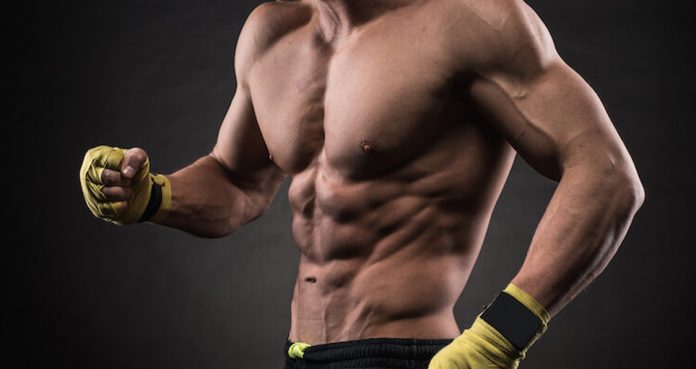
Build Shredded Obliques With This Workout
Get Ripped Obliques with this Workout
A midriff cannot be deemed complete without shredded obliques. Obliques are the fish gill-like muscles present on the side of your abs. Most people are too busy performing crunches and hanging leg raises that they completely forget about training their obliques.
While it is important to have a low body fat percentage to show the obliques, you still need to train them. The obliques need to be trained for both function and show. The oblique family plays a major role in many different movements and are an essential part of the core.
1. Cable Woodchoppers – 3 Sets 15 Reps
Unlike the free weight, cables are incredibly effective in maintaining constant tension on your working muscles. Cable woodchoppers target your obliques and will give you a muscle tearing pump by the end of the exercise.
Attach a D-handlebar to a tower, and move the cable to the highest pulley position. Stand at an arm’s distance from the pulley. With your right side to the cable, grab the bar with both hands. In one motion, pull the handle down and across your body to your front knee while rotating your torso. Repeat with your left side.
2. Decline Bench Oblique Crunches – 3 Sets 20-15-15 Reps
The decline oblique crunches are one of the most underutilized exercises. It’s important to squeeze and contract your obliques while performing these exercises and maintain a full range of motion.
Lie on your left side on a decline bench. Keep your right hand on the back of your head and place your left hand on your right obliques. Touch the bench at the bottom of the movement and your upper body should be perpendicular to the floor at the top of the movement. Repeat on your right side.
3. Side Planks – 3 Sets 1 Minute, 45, 45 Seconds on Each Side
Planks have earned a name for themselves for being a great core builder. Planks exploded onto the scene with the introduction of CrossFit. Side planks are a plank variation which helps in building definition in your obliques.
Start on your side with your feet place one on top of the other and one forearm directly below your shoulder. Raise your hips and contract your core until your body is in a straight line. Don’t let your hips fall down during the working set.
4. Landmines – 3 Sets 15 Reps Each Side
Landmines are a great core builder and your obliques take the most beating in this exercise. If you don’t have the landmine equipment at your gym, you can perform this exercise by placing a barbell in a corner and holding one end of the barbell with both your hands.
Stand with your feet shoulder-width apart while holding the barbell with both hands in front of your face. Keep your elbows locked out while you twist to your right side. Go as far as you can without twisting to your hips. Return to the starting position and repeat for the left side.
5. Russian Twists
Russian twists are one of the most common oblique exercises. Most people make the mistake of going too heavy on this exercise. Use a weight plate or a dumbbell with which you can follow a full controlled range of motion.
Sit with your feet placed flat on the floor and your back at a 60-degree angle. Hold a weight plate over your knees with your arms stretched out. Rotate to your right side and contract your obliques. Return to the starting position and repeat for the left side.
Which is your favorite oblique exercise? Let us know in the comments below. Also, be sure to follow Generation Iron on Facebook, Twitter, and Instagram.
*Header image courtesy of Envato Elements.
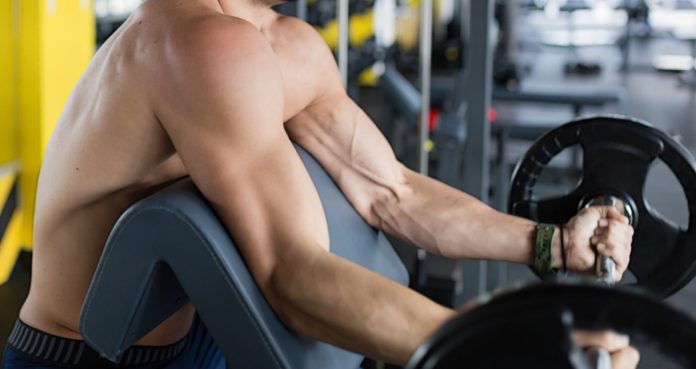
Top 10 Exercises For Increasing Bicep Size
Top 10 Exercises For Increasing Bicep Size
Everyone wants have some impressive guns to show off when they rip off their shirt at the beach. In order to get extraordinary looking biceps it requires hard work, dedication, and the right programming for ultimate success. This article breaks down all the requirements needed to build some awesome biceps!
Isolation Exercises for The Biceps
While the biceps are a relatively small muscle, many look to improve their appearance by increasing the size of their biceps. This is most commonly done by incorporating a number of bicep “isolation” exercises which place a maximal stress on the muscle and force it to adapt.
The biceps are a muscle found in the upper arm which are primarily responsible for flexing the elbow. It is a two headed muscle which means that the muscle originates from two different points on the scapula (shoulder blade). This therefore means that, along with flexing the elbow, the biceps assist in generating and controlling movement of the shoulder too.
With this understanding, in order to properly perform bicep isolation exercises, the movements involved with each exercise must revolve around elbow flexion, extension and shoulder rotation.
Muscular Growth Requirements
Before assessing 10 of the best bicep exercises, we must consider two major influencers in the muscle building process. To optimize the rate of muscle growth, it is essential to increase the number of calories and protein consumed in the daily diet. Failing to do so will not allow significant changes in muscle mass to be made.
Consuming more calories is the first requirement of muscle building. Calories are a unit of measurement for energy and therefore, the higher the amount of calories consumed, the greater amount of energy available for the body.
This additional energy is needed by the body to speed up the recovery process after resistance training sessions. The amount of calories required will vary from person to person as a result of sex, physical characteristics and activity levels.
Increasing the amount of protein consumed daily should also considered when looking to enhance muscle size. Protein is the macronutrient responsible for all growth and repair within the body and therefore, it also plays a crucial role in building muscle size. For those aiming to increase muscle size, the recommendation for daily protein consumption is to consume between 1.0 – 1.6 grams per kilogram of Bodyweight (1).
Only once these two factors have been put in place can physical training be considered. For building size in the biceps, a combination of compound and bicep isolation exercises should be used. Compound exercises are “big” movements which utilize many muscles whereas isolation exercises focus on just one muscle group. As suggested previously, isolation exercises are highly important for maximizing bicep development.
When it comes to strength training there are a number of factors that need to be considered, such as training frequency and training volume. Research suggests that for optimal muscle growth, each muscle group should be trained multiple times per week. By repeatedly placing a demand on the muscles of the body, they must adapt rapidly which leads to an increase in muscle strength and size (2).
Lastly, training volume is a topic that has been rigorously researched over the years – specifically the impact of heavy weight, low reps and light weight, high reps training on hypertrophy. While there are a number of differing opinions on this topic, studies indicate that both methods are equally as effective for building muscle (3). Providing training is kept regular, the method that is used to elicit hypertrophy is of little consequence.
The Top 10 Bicep Builders
As will soon be apparent, there is a lot more to bicep training than just the simple bicep curl. The following list includes exercises which manipulate the hand position and use different pieces of gym equipment to apply a stimulus to the bicep in a different way. Training doesn’t have to be boring and I hope that the following list will provide a bank of interesting and diverse bicep exercises that can be added to workouts.
Let’s begin with some barbell-based exercises…
1) Conventional Barbell Curl
Probably the most common bicep builder in the list. This barbell curl will allow the greatest amount of weight to be lifted in comparison to any other exercise. This is because a barbell forces the body into a fixed position and therefore stability becomes enhanced. Being more stable while moving through the range of any exercise will have a positive impact on performance and allow for heavier loads to be lifted.
A recent study reviewed the EMG levels during three bicep exercises and found that the barbell brought about a greater activation of the muscle than dumbbells. EMG simply refers to the electrical activity present within the muscle. Therefore, the barbell curl is extremely effective at targeting the biceps (4).
To perform the barbell curl, grab the barbell with hands approximately shoulder-width apart and stand tall with the chest up. From that position, with arms extended, pin the elbows in tight to the ribcage and focus on hinging only at the elbow. By doing so, the forearm should rise up until the hands are approximately in line with the shoulder before lowering the bar back to the starting position.
It is thought that by adjusting the width of the grip, it is possible to target different parts of the bicep. By narrowing the grip the demand will be placed more on the long head of the bicep whereas a wider grip will shift the demand onto the short head.
2) Wide-Grip Barbell Curl
Leading directly on from this, we have the wide-grip barbell curl. For comprehensive bicep development, it’s important to target the different heads equally and, as mentioned, this is a superb variation that can be used to target the short head of the bicep.
The reason the wide-grip is so effective for short head activation comes down to the biceps control over shoulder movement. By gripping the bar slightly wider than shoulder-width, external rotation of the shoulder occurs. This external rotation changes the position of the upper arm which has a direct impact on the activity of the short head.
3) EZ-Bar Curl
The final barbell-based bicep exercise is the EZ-bar curl. The EZ bar is an undulating barbell which allows the user to grasp the bar with a greater degree of comfort. The bends in the bar take away some of the tension in the wrists and forearm which can be a great help, especially when lifting heavy loads.
In the same bicep study (4), the EZ-bar was also found to activate the biceps brachii to a greater extent when compared to a dumbbell curl. Small, insignificant differences were found between the conventional and EZ curl and therefore, personal preference should dictate which variation to use.
With all barbell exercises and heavy loads, it can be tempting to use other body parts in order to get the bar up. One of the more common ways of doing this is to drive the hips through powerfully to get the barbell moving. Remember, that the bicep curl is an isolation exercise with the purpose of stressing only the biceps and, as a result, the only joint that should move is the elbow.
4) Dumbbell Bicep Curl
Next, we have dumbbell-based bicep exercises. Although the previous study suggested that the bicep curl with dumbbells may not be as effective for bicep activation, it should certainly not be disregarded. As stated earlier, dumbbells are far less stable than barbells; one of the benefits of this is that the surrounding stabilizing musculature is forced to engage in order to facilitate form.
Another positive regarding dumbbells, is their versatility. With the barbell curl, there is a limit to the number of variations that can be performed; not so with the dumbbells, as will soon become clear.
Furthermore, the dynamic of the curl can be altered by adjusting the grip used. With the dumbbell, it is possible to apply a load to the biceps in many different ways by using different grips or by manipulating the arm position. By using two individual weights, shoulder rotation can take place with exercises such as the dumbbell bicep curl. The barbell, on the other hand, only allows for a limited number of different grips and does not allow for any rotation to take place.
5) Dumbbell Hammer Curl
One final benefit that the dumbbells have over the barbell is that the dumbbells may allow for a slightly greater range of motion. With the barbell, as soon as the bar touches the hips, it can go no further. With dumbbells however, the arms can fully extend so that the weight is held by the side of the hips. This stretches out the bicep to its maximum potential prior to contracting.
The hammer position involves holding the dumbbells with a neutral grip (palms facing the hips) and requires a great deal of work from all elbow flexing muscles. This grip may allow for a more powerful contraction from the biceps and therefore, some individuals may find this variation easier to perform than the conventional curl.
6) Zottman Curl
This is potentially a new exercise for many however, it’s an extremely effective bicep developer. This is one exercise that effectively combines dumbbells and rotation. The biceps assist in the action of rotating of the forearm which explains why rotation is utilized in this exercise.
With the Zottman curl, the arms start extended down by the hips with the palms facing away from the body. A standard curl is performed until the dumbbells are elevated in line with the shoulders. A short pause is taken at that point of peak bicep contraction to allow a rotation through the shoulder to take place. Once this full rotation has occurred, the dumbbells are then lowered back to the original position and the movement repeated for the desired number of reps.
7) Dumbbell Concentration Curl
The concentration curl is an important exercise for anyone who is struggling to move only through the elbow. The technique required for this exercise involves using the knee to support the arm thus preventing the upper arm from moving back or forth. By preventing this from occurring, it is impossible to “cheat” and therefore, the biceps must complete all the work.
To complete the concentration curl, either from a standing or seated position, place the elbow on the inside of the knee. Starting with the arm fully extended, drive the dumbbell up to the shoulders and return in a controlled manner.
8) Incline Dumbbell Curl
By placing a bench on an incline and lying back on it, the elbows moves away from the side of the ribcage to behind the body. Research indicates that this change in position increases the stretch placed on the long head of the biceps (5). Additionally, the bench can be considered a useful addition as it minimizes movement from the trunk of the body and therefore may facilitate better form.
As a consequence of both of these, the incline curl is likely to be more challenging to complete in comparison to free-standing bicep curl exercises.
9) Incline Dumbbell Inner-Biceps Curl
This exercise is almost identical to the aforementioned incline bicep curl and also stretches the long head maximally. The only difference between the two exercises is the position that the dumbbells are held. For the inner-bicep curl, the dumbbells should start wider than the hips and that angle should then be maintained throughout the duration of the movement.
10) Overhead Cable Curl
The final bicep exercise moves away from dumbbells and barbells and instead uses the cables. The overhead cable curl involves adjusting the pulleys so that they are approximately in line with the shoulders. From that position, grasp the handles and ensure that the wrist, elbow and shoulder are all in a straight line, parallel to the floor. From that position, brace hard to enhance stability, and focus on powerfully contracting the biceps so that the hands come in towards the side of the head.
Final Word
Providing a calorie deficit, high protein diet and adequate resistance training are all implemented, muscles will begin to grow. Now, this is not intended to be a comprehensive list of all bicep exercises, rather the purpose was to provide a number of options to keep training interesting and the bicep growing!
For more news and updates, follow Generation Iron on Facebook, Twitter, and Instagram.
References:
1- Food Funct. 2016 Mar;7(3):1251-65. doi: 10.1039/c5fo01530h. PMID: 26797090 DOI: 10.1039/c5fo01530h
2- Schoenfeld, Brad J.; Ratamess, Nicholas A.; Peterson, Mark D.; Contreras, Bret; Tiryaki-Sonmez, Gul (2015-7). “Influence of Resistance Training Frequency on Muscular Adaptations in Well-Trained Men”. Journal of Strength and Conditioning Research. 29 (7): 1821–1829. doi:10.1519/JSC.0000000000000970. ISSN 1533-4287. PMID 25932981.
3- Schoenfeld, Brad J.; Peterson, Mark D.; Ogborn, Dan; Contreras, Bret; Sonmez, Gul T. (2015-10). “Effects of Low- vs. High-Load Resistance Training on Muscle Strength and Hypertrophy in Well-Trained Men”. Journal of Strength and Conditioning Research. 29 (10): 2954–2963. doi:10.1519/JSC.0000000000000958. ISSN 1533-4287. PMID 25853914.
4- Marcolin, Giuseppe; Panizzolo, Fausto Antonio; Petrone, Nicola; Moro, Tatiana; Grigoletto, Davide; Piccolo, Davide; Paoli, Antonio (July 13, 2018). “Differences in electromyographic activity of biceps brachii and brachioradialis while performing three variants of curl”. PeerJ. 6. doi:10.7717/peerj.5165. ISSN 2167-8359. PMC PMCPMC6047503. PMID 30013836.
5- Oliveira, Liliam F.; Matta, Thiago T.; Alves, Daniel S.; Garcia, Marco A.C.; Vieira, Taian M.M. (March 1, 2009). “Effect of the shoulder position on the biceps brachii emg in different dumbbell curls”. Journal of Sports Science & Medicine. 8 (1): 24–29. ISSN 1303-2968. PMC PMCPMC3737788. PMID 24150552.
